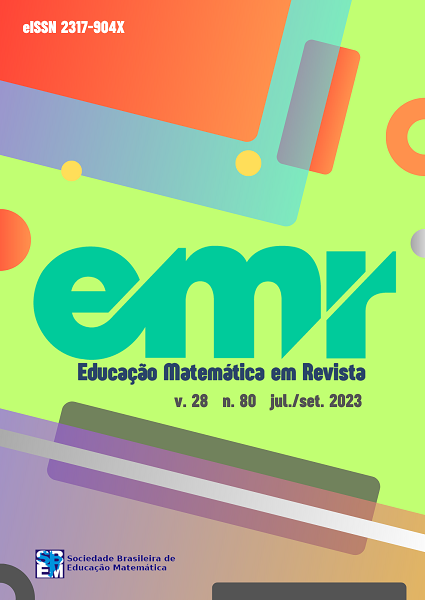An analysis of the kantian influence on the acceptance of non-eucliden geometries
DOI:
https://doi.org/10.37001/emr.v28i80.3554Keywords:
Non-euclidean geometries, Philosophy, Kant, History of Mathematics, Euclidean geometryAbstract
This article, of a bibliographic nature, seeks to analyze the influences of Kantian philosophy on the acceptance of non-Euclidean Geometries. Historical records indicate that until the mid-19th century, Euclidean Geometry was considered the only possible geometry. It was then that non-Euclidean Geometries appeared. Such geometries were not easily accepted by the mathematical community and remained in the obscure field of mathematics for some time. At this same time, the dominant philosophy, both for the church and for the academic community, was Kantian philosophy. The main objective of this work is to discuss the influence of Kantian philosophy on the acceptance of non-Euclidean Geometries. The conclusions indicate that there was an influence of Kantian philosophy on the acceptance of non-Euclidean Geometries, however, it was the ideal of Euclidean Geometry that caused the mathematical community not to accept the existence of new geometries. Non-Euclidean Geometries were considered aberrations of human knowledge and remained in the shadow of mathematics until the moment they met the new discourses produced by capitalist society and were used to refute Kantian apriorism.
Downloads
References
ABBAGNANO, N. Dicionário de Filosofia; tradução da 1ª edição brasileira coordenada e revista por BOSSI, A., BENEDETTI, I. C. 5º ed., São Paulo: Martins Fontes, 2007.
BARBOSA, J. L. M. Geometria hiperbólica. IMPA, Rio de Janeiro: IMPA, 1995.
BRITO, A. J. Geometrias não-euclidianas: Um estudo histórico-pedagógico. 1995. 187 f. Dissertação (Mestrado em Matemática) – Faculdade de Educação, Universidade Estadual de Campinas, São Paulo, 1995.
CABARITI, E. Geometria Hiperbólica: uma proposta didática em ambiente informatizado. 2004. 131 f. Dissertação (Mestrado) – PontifÃcia Universidade Católica de São Paulo, São Paulo, 2004.
DESCARTES, R. Discurso do Método. Tradução: Enrico Corvisieri. eBooksBrasil: Acrópolis, 2002. DisponÃvel em: http://br.egroups.com/group/acropolis. Acesso em: 12 maio
EUCLIDES. Os Elementos/Euclides; tradução e introdução de Irineu Bicudo. – São Paulo: Editora Unesp, 2009.
FERREIRA, L. Uma proposta de ensino de Geometria Hiperbólica: “construção do Plano de Poincaré†com o uso do software Geogebra. Dissertação (Programa de Pós-Graduação em Educação para a Ciência e a Matemática) – Departamento de Matemática, Universidade Estadual de Maringá, Maringá, Paraná, 2011. DisponÃvel em: http://repositorio.uem.br:8080/jspui/handle/1/4513. Acesso em: 25 junho 2022.
HUME, D. Investigação Acerca do Entendimento Humano [1748]. Tradução de AIEX, A. eBooksBrasil: Acrópolis, 2006. DisponÃvel em: http://br.egroups.com/group/acropolis. Acesso em: 05 abril 2023.
KANT, E. CrÃtica da Razão Pura. Tradução de MERGE, R. de. eBooksBrasil: Acrópolis, 2001. DisponÃvel em: http://br.egroups.com/group/acropolis. Acesso em: 12 abril 2023.
LEAL, G. Kant e as Geometrias não-euclidianas. Revista Ciências Humanas, São Paulo, v.4, n.2, p.103-108, 2004.
MENEGHETTI, R. C. G. Constituição do saber matemático: reflexões filosóficas e históricas. Londrina: EDUEL, 2010.
MLODINOW, L. A Janela de Euclides. São Paulo: Geração Editorial, 2004.
Published
How to Cite
Issue
Section

This work is licensed under a Creative Commons Attribution-NonCommercial-ShareAlike 4.0 International License.






